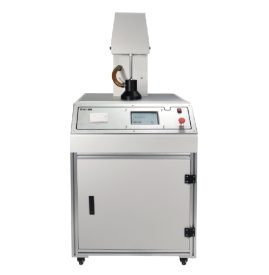
Mask particle protection effect detector
The particle protection effect tester for masks is equipped with a national standard head mold placed in a 500L self-cleaning detection chamber. The mask to be tested is worn on the head mold, and the median diameter of the mass produced is 0.6 μ m. Salt aerosol with a concentration of 25mg/m3 and a median mass diameter of 0.3 μ m. An oily aerosol with a concentration of 25mg/m3 is inputted into the self purification detection cabin. The head model is simulated with a sinusoidal curve to simulate respiration. The concentration of salt and oil aerosols before and after the mask is sampled and detected using upstream and downstream photometers, and the filtration efficiency of mask particles is calculated. The mask to be tested can be worn on the national standard head mold to automatically detect respiratory resistance. Applicable to medical device inspection institutes, disease prevention and control centers, hospitals, high-efficiency filter manufacturers, mask R&D and production manufacturers, etc., to test the filtration efficiency of particulate matter such as masks and filter media.
Execution standards:
GB/T6165-2008 Performance Test Methods for High Efficiency Air Filters - Technical Requirements and Test Methods for Efficiency and Resistance of Particle Protection
GB/2626-2006 Respiratory protective equipment - Self suction filtering particulate respirators
GB/T 32610-2016 Technical Requirements for Daily Protective Masks
Technical features:
Integrated design of particulate matter filtration efficiency detection and respiratory resistance detection for masks, with multiple uses for one machine.
The self-cleaning detection cabin is equipped with operating gloves to facilitate the replacement of the mask to be inspected.
Compatibility design for three types of head molds, plug and play for easy replacement.
External salt and oil aerosol generators can be controlled to control the concentration of particulate matter.
Large touch display design, automatically displaying respiratory flow curve and automatically calculating particulate matter filtration efficiency.
The whole process particulate matter leakage prevention design protects the safety of experimental personnel.
Photometer long-life laser light source, high-precision photomultiplier tube detection.
Photometer working time statistics, automatically indicating cleaning time.
Automatically count the usage time of high-efficiency filters and prompt for replacement.
Historical data can be exported through a USB drive or printed through an embedded printer.
Technical indicators:
1. Using a cold aerosol generator to generate continuous and stable aerosol particles, it is convenient to add the solution.
2. Using high-precision PM2.5 sensors to measure aerosol concentration.
3. The whole process particulate matter leakage prevention design protects the safety of experimental personnel.
4. Two sets of aerosol generators: salt particle aerosol generator and oil particle aerosol generator.
5. Equipped with a static charge neutralization device for aerosol particles.
6. Configure temperature and humidity sensors to display real-time environmental temperature and humidity (temperature and humidity requirements: 25 ± 5, 30% RH ± 10% RH).
7. Configure a laser dust particle counter.
8. The protective effect test chamber is designed with a front door opening, good sealing, and equipped with operating gloves for easy replacement of the mask to be inspected.
9. The protective effect test adopts a standard head mold: one standard head mold, which simulates the real situation of a person wearing a protective mask.
10. Protective effect of aerosol particles: Test chamber concentration range (20-30) mg/m3, adjustable setting, concentration fluctuation less than ± 10%; Aerosol generator produces particle size distribution of 0.02-2 μ m. Median diameter of mass: 0.6 for salt particles μ m. Oil particles 0.3 μ M.
11. Protective effect aerosol concentration detection device: gas sampling flow rate (1-2) L/min, sampling frequency: 20 times/min (1-9999 times/min can be set arbitrarily), dynamic detection (0.001-100) mg/m3, accuracy of 1%.
12. Protective effect: The inhalation gas sampling tube is located directly below the nostril (in the oral cavity).
13. The protective effect adopts a respiratory simulator to simulate the breathing state of the human body.
14. Respiratory simulator: Sinusoidal airflow, frequency 20 times/min, respiratory flow control (30 ± 1) L/min, respirator flow range: 0-40 L/min.
15. Instrument accuracy level (accuracy level): Level 1
16. Control system: Computer controls the testing process, automatically collects data, and configures dedicated computers and testing software.
17. Computer automatic testing and display: concentration of medium in the warehouse, concentration of inhaled gas medium, and background concentration; Automatic calculation: protective effect; Can save, output, query, and print test data.
Prev: Mask tightness tester